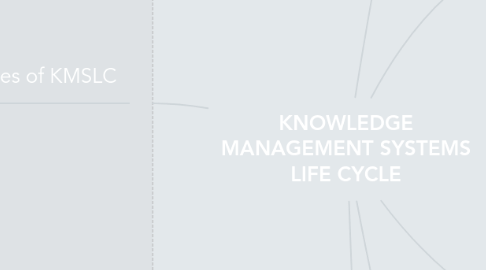
1. Stages of KMSLC
1.1. (1) Evaluate Existing Infrastructure
1.1.1. System justifications
1.1.1.1. What knowledge will be lost through retirement, transfer, or departure to other firms?
1.1.1.2. Is the proposed KM system needed in several locations?
1.1.1.3. Are experts available and willing to help in building a KM system?
1.1.1.4. Does the problem in question require years of experience and tacit reasoning to solve?
1.1.2. The Scope Factor
1.1.2.1. Consider breadth and depth of the project within financial, human resource, and operational constraints
1.1.2.2. Project must be completed quickly enough for users to foresee its benefits
1.1.2.3. Check to see how current technology will match technical requirements of the proposed KM system
1.1.3. Role of Strategic Planning
1.1.3.1. Risky to plunge into a KMS without strategy
1.1.3.2. Knowledge developer should consider:
1.1.3.2.1. Vision
1.1.3.2.2. Resources
1.1.3.2.3. Culture
1.2. (2) Form the KM Team
1.2.1. Identify the key stakeholders of the prospective KM system.
1.2.2. Team success depends on: Ability of team members Team size Complexity of the project Leadership and team motivation
1.3. (3) Knowledge Capture
1.3.1. Explicit knowledge captured in repositories from various media
1.3.2. Tacit knowledge captured from company experts using various tools and methodologies
1.3.3. Knowledge developers capture knowledge from experts in order to build the knowledge base
1.3.4. Selecting an Expert
1.3.4.1. How does one know the expert is in fact an expert?
1.3.4.1.1. What makes someone an expert:
1.3.4.2. How would one know that the expert will stay with the project?
1.3.4.3. What backup should be available in case the project loses the expert?
1.3.4.4. How could we know what is and what is not within the expert’s area of expertise
1.4. (4) Design the KM Blueprint
1.4.1. The KM blueprint addresses several issues
1.4.1.1. Finalize scope of proposed KM system with realized net benefits
1.4.1.2. Decide on required system components
1.4.1.3. Develop the key layers of the KM software architecture to meet company requirements
1.4.1.4. System interoperability and scalability with existing company IT infrastructure
1.5. (5)Testing the KM System
1.5.1. Verification procedure: ensures that the system has the right functions
1.5.2. Validation procedure: ensures that the system has the right output
1.5.3. Validation of KM systems is not foolproof
1.6. (6) Implement the KM System
1.6.1. Converting a new KM system into actual operation: -includes conversion of data or files -also includes user training
1.6.2. Quality assurance is important, which includes checking for: -Reasoning errors -Ambiguity -Incompleteness -False representation (false positive and false negative)
1.7. (7) Manage Change and Rewards Structure
1.7.1. Goal is to minimize resistance to change -Experts -Regular employees (users) -Troublemakers
1.7.2. Resistances via projection, avoidance, or aggression
1.8. (8) Post-system Evaluation
1.8.1. Assess system impact in terms of effects on: -People -Procedures -Performance of the business
1.8.2. Areas of concern: -Quality of decision making -Attitude of end users -Costs of Knowledge processing and update
2. Motivation
2.1. For any task, from as simple as planning a trip, working on a maths problem The process involves a number of steps until you come up with a solution.,
2.2. In developing a large software system used in industry, the process also follows a number of defined steps which are accepted as best practices by practitioners
2.3. -How many programming courses have you taken either here or elsewhere before? -What would be the steps you would take in completing a programming assignment
2.4. read the problem statement mentally think about how to solve it select a programming language (if decided, select what kind of data structures) translate into program code compile, run and test modify if program doesn't function as expected Satisfied!!
3. CHALLENGES IN BUILDING KM SYSTEMS
3.1. Culture:
3.1.1. getting people to share knowledge
3.2. Knowledge evaluation
3.2.1. assessing the worth of knowledge across the organization
3.3. Knowledge processing
3.3.1. documenting how decisions are reached
3.4. Knowledge implementation
3.4.1. organizing knowledge
